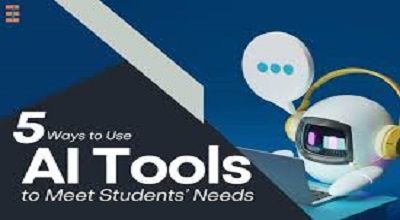5 Ways to Use AI Tools to Meet Students’ Needs
Now here latest 5 Ways to Use AI Tools to Meet Students’ Needs. Artificial Intelligence (AI) tools have the potential to significantly enhance the educational experience by providing personalized learning opportunities and addressing individual students’ needs. Here are five ways to use AI tools to meet students’ needs:
Personalized Learning Paths:
- AI can analyze students’ performance data, such as test scores, homework completion rates, and learning pace, to create personalized learning paths. These paths can recommend specific lessons, exercises, or resources tailored to each student’s strengths and weaknesses. Adaptive learning platforms like Khan Academy and DreamBox already use AI to offer customized learning experiences.
Intelligent Tutoring Systems:
- AI-powered intelligent tutoring systems can provide real-time assistance to students. These systems can identify when a student is struggling with a particular concept or problem and offer immediate feedback and guidance. This one-on-one support can help students grasp difficult subjects more effectively. Examples of intelligent tutoring systems include Carnegie Learning and Knewton.
Automated Grading and Feedback:
- AI tools can automate the grading process for assignments, quizzes, and tests. This not only saves teachers time but also allows for faster and more consistent feedback to students. AI can also provide detailed feedback, pointing out specific mistakes and offering suggestions for improvement. Platforms like Turnitin and Gradescope use AI for plagiarism detection and grading.
Predictive Analytics:
- Predictive analytics powered by AI can identify students at risk of falling behind or dropping out. By analyzing various factors such as attendance, engagement, and performance data, schools and institutions can intervene early and provide additional support to these students. This proactive approach can help improve retention rates and student success.
Natural Language Processing (NLP) for Language Learning:
- AI-driven NLP tools can assist students in learning languages more effectively. These tools can provide pronunciation feedback, grammar correction, and vocabulary enhancement suggestions. They can also engage students in interactive conversations to practice speaking and listening skills. Duolingo and Babbel are examples of platforms that incorporate AI for language learning.
Summary
It’s essential to implement 5 Ways to Use AI Tools to Meet Students’ Needs in Education thoughtfully, considering ethical and privacy concerns. Additionally, educators should work in tandem with AI to ensure that technology complements their teaching methods and enhances the overall learning experience. While AI can play a significant role in meeting students’ needs, it should be part of a holistic approach to education that combines technology with human guidance and support.
